Peanut sauce is a delectable condiment with a rich and creamy texture that adds a burst of flavor to various dishes. But have you ever wondered about its calorie content and nutritional value?
In my research on peanut sauce calories, I found that there is a variety of peanut butter options available, including crunchy and creamy. Crunchy peanut butter contains small pieces of roasted peanuts and tends to have a slightly stronger peanut flavor. It is versatile and can be used in both sweet and savory dishes. Creamy peanut butter, on the other hand, is made by grinding roasted peanuts until smooth and silky. It offers a velvety texture and pairs well with fruits, chocolate, and savory ingredients.
In terms of nutritional benefits, both types of peanut butter provide healthy monounsaturated fats, protein, fiber, and essential vitamins and minerals. The calorie content of creamy peanut butter is typically slightly lower than that of crunchy peanut butter. Crunchy peanut butter tends to have slightly higher sugar content due to added sugar particles for texture. When it comes to comparing the nutritional benefits of crunchy vs creamy peanut butter, it ultimately comes down to personal preference and the specific culinary application.
Additionally, I discovered that PBfit, a popular peanut butter powder, is a versatile product that offers the flavor of peanut butter with fewer calories and less fat. It contains 87% less fat than traditional peanut butter and is high in protein and fiber. PBfit is also lower in sodium and contains essential vitamins and minerals. It does not have added sugar and is non-GMO and gluten-free. PBfit is a versatile ingredient that can be used in various ways and is widely available and affordable. However, it is essential to read nutrition labels and choose products with minimal additives. Overall, PBfit is a nutritious alternative to traditional peanut butter that can be a great option for those looking to maintain a balanced diet.
Key Takeaways:
- Crunchy and creamy peanut butter are common ingredients in peanut sauce recipes, each offering a unique flavor and texture.
- Creamy peanut butter tends to have a slightly lower calorie content compared to crunchy peanut butter.
- PBfit is a popular peanut butter powder that provides a lower calorie and healthier alternative to traditional peanut butter.
- PBfit is high in protein, fiber, and essential vitamins and minerals, making it a nutritious option for homemade peanut sauce.
- When selecting peanut butter products, it is important to read nutrition labels and choose those with minimal additives.
To understand the calorie content of peanut sauce, let’s first take a closer look at its primary ingredient – peanut butter. Peanut butter comes in different types, such as crunchy and creamy, each with its own unique characteristics and nutritional benefits.
Crunchy peanut butter contains small pieces of roasted peanuts and offers a slightly stronger peanut flavor. It adds a delightful crunch to your dishes, making it a versatile option for both sweet and savory recipes. On the other hand, creamy peanut butter is made by grinding roasted peanuts until smooth and silky. It offers a velvety texture and pairs wonderfully with fruits, chocolate, and other savory ingredients.
In terms of nutritional value, both crunchy and creamy peanut butter are rich sources of healthy monounsaturated fats, which can contribute to heart health. They also contain protein, fiber, and essential vitamins and minerals like vitamin E, niacin, and magnesium. These nutrients play a crucial role in supporting overall health and well-being.
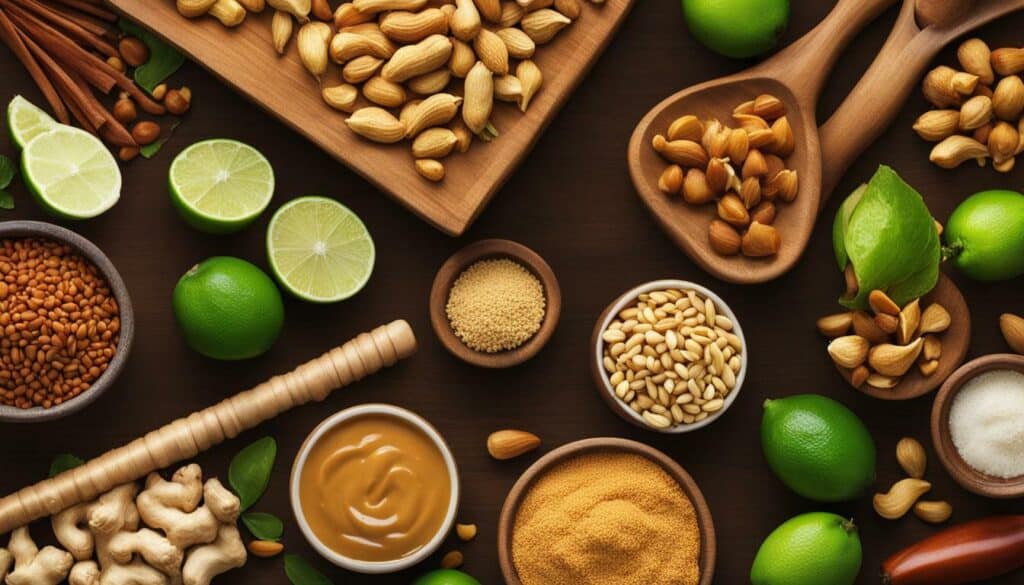
When comparing the calorie content of crunchy and creamy peanut butter, it’s important to note that creamy peanut butter typically has a slightly lower calorie count. This is because the small pieces of roasted peanuts in crunchy peanut butter add some extra calories. However, it is important to remember that the difference in calorie content between the two types is minimal.
Both crunchy and creamy peanut butter may contain added sugar, but the sugar content is generally higher in crunchy peanut butter due to the added sugar particles that provide its distinctive texture. If you’re looking for a healthier option, it’s advisable to choose peanut butter with minimal or no added sugar.
Summing it up:
- Crunchy peanut butter contains small pieces of roasted peanuts and offers a slightly stronger peanut flavor.
- Creamy peanut butter is smooth and silky, providing a velvety texture that pairs well with various ingredients.
- Both types of peanut butter are rich in monounsaturated fats, protein, fiber, and essential vitamins and minerals.
- Creamy peanut butter typically has a slightly lower calorie count compared to crunchy peanut butter.
- Crunchy peanut butter may have higher sugar content due to added sugar particles for texture.
- Choose peanut butter with minimal or no added sugar for a healthier option.
By understanding the different types of peanut butter and their nutritional benefits, you can make an informed choice when selecting the right peanut butter for your peanut sauce recipe.
Crunchy vs Creamy Peanut Butter: Which is Lower in Calories?
When it comes to choosing between crunchy and creamy peanut butter for your peanut sauce, you might be wondering which one is lower in calories. In my research on peanut sauce calories, I found that both types of peanut butter have similar calorie content, but there are subtle differences to consider.
Crunchy peanut butter contains small pieces of roasted peanuts and tends to have a slightly stronger peanut flavor. It is versatile and can be used in both sweet and savory dishes. On the other hand, creamy peanut butter is made by grinding roasted peanuts until smooth and silky. It offers a velvety texture and pairs well with fruits, chocolate, and savory ingredients.
In terms of nutritional benefits, both types of peanut butter provide healthy monounsaturated fats, protein, fiber, and essential vitamins and minerals. However, the calorie content of creamy peanut butter is typically slightly lower than that of crunchy peanut butter.
| Type of Peanut Butter | Calories (per 2 tablespoons) |
|---|---|
| Crunchy Peanut Butter | 190 calories |
| Creamy Peanut Butter | 180 calories |
While the difference in calories may seem small, it can add up over time, especially if you frequently use peanut butter in your cooking and sauces. Additionally, it’s worth noting that crunchy peanut butter tends to have slightly higher sugar content due to added sugar particles for texture.
When it comes to comparing the nutritional benefits of crunchy vs creamy peanut butter, it ultimately comes down to personal preference and the specific culinary application. If you prefer a stronger peanut flavor and enjoy the added crunch, go for crunchy peanut butter. If you prefer a smooth and silky texture, creamy peanut butter is the way to go.
Overall, both types of peanut butter can be a delicious and nutritious addition to your peanut sauce recipes. Just be mindful of portion sizes and choose the type that suits your taste preferences and dietary needs. Remember, moderation is key when it comes to enjoying peanut butter in a balanced diet.
Sugar Content in Crunchy and Creamy Peanut Butter
In addition to calorie content, it is important to consider the sugar content when making a healthy peanut sauce. Peanut butter, whether crunchy or creamy, can vary in the amount of added sugar it contains. For a truly nutritious sauce, it’s essential to choose a peanut butter with minimal added sugar.
When comparing crunchy and creamy peanut butter, it’s worth noting that crunchy varieties tend to have slightly higher sugar content. The crunchy texture is achieved by adding small particles of sugar to the peanut butter, which enhances the overall mouthfeel. This process adds a subtle sweetness and might be more appealing to those with a sweet tooth.
On the other hand, creamy peanut butter typically has a lower sugar content. The smooth texture doesn’t require the addition of sugar particles for that extra crunch. Some brands even offer sugar-free options, making them a great choice for those looking for a healthier alternative without sacrificing taste.
Table: Sugar Content in Crunchy and Creamy Peanut Butter
| Peanut Butter Type | Sugar Content (per serving) |
|---|---|
| Crunchy Peanut Butter | 1-2 grams |
| Creamy Peanut Butter | 0-1 gram |
As you can see from the table above, both crunchy and creamy peanut butter have relatively low sugar content per serving. However, if you’re watching your sugar intake or prefer a more natural peanut butter taste, choosing a creamy variety or a sugar-free option might be the better choice for your peanut sauce recipe.
By being mindful of the sugar content in your peanut butter, you can make a healthier and more nutritious peanut sauce that still delivers on flavor. Experiment with different types of peanut butter to find the one that best suits your taste preferences and dietary needs.
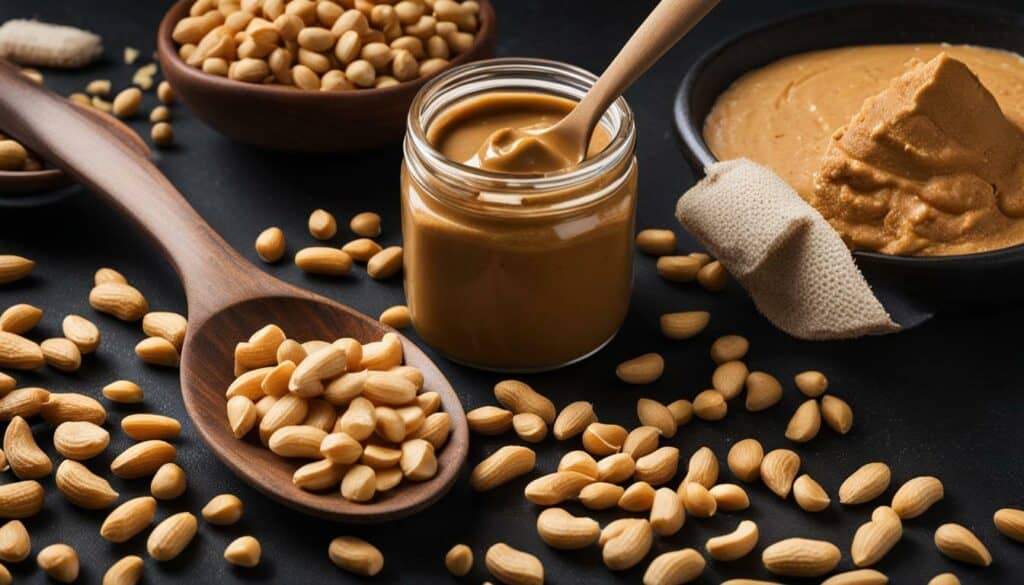
If you’re looking to reduce the calorie content in your peanut sauce without compromising on flavor, PBfit may be a nutritious alternative worth exploring. In my research on peanut sauce calories, I found that there is a variety of peanut butter options available, including crunchy and creamy.
Crunchy peanut butter contains small pieces of roasted peanuts and tends to have a slightly stronger peanut flavor. It is versatile and can be used in both sweet and savory dishes. Creamy peanut butter, on the other hand, is made by grinding roasted peanuts until smooth and silky. It offers a velvety texture and pairs well with fruits, chocolate, and savory ingredients.
In terms of nutritional benefits, both types of peanut butter provide healthy monounsaturated fats, protein, fiber, and essential vitamins and minerals. The calorie content of creamy peanut butter is typically slightly lower than that of crunchy peanut butter. Crunchy peanut butter tends to have slightly higher sugar content due to added sugar particles for texture.
When it comes to comparing the nutritional benefits of crunchy vs creamy peanut butter, it ultimately comes down to personal preference and the specific culinary application. However, I discovered that PBfit, a popular peanut butter powder, is a versatile product that offers the flavor of peanut butter with fewer calories and less fat. It contains 87% less fat than traditional peanut butter and is high in protein and fiber. PBfit is also lower in sodium and contains essential vitamins and minerals. It does not have added sugar and is non-GMO and gluten-free.
PBfit is a versatile ingredient that can be used in various ways and is widely available and affordable. However, it is essential to read nutrition labels and choose products with minimal additives. Overall, PBfit is a nutritious alternative to traditional peanut butter that can be a great option for those looking to maintain a balanced diet.
Benefits and Nutritional Profile of PBfit
PBfit is not only lower in calories but also boasts several beneficial qualities that make it a nutritious choice for peanut sauce. This popular peanut butter powder is made from gently roasted peanuts that undergo a unique process to extract the oil, resulting in a reduced-fat product. With 87% less fat than traditional peanut butter, PBfit offers a healthier option for those watching their calorie intake.
Aside from being lower in calories, PBfit is also high in protein and fiber. It contains 8 grams of protein and 5 grams of fiber per serving, making it a great addition to peanut sauce recipes for added nutritional value. Protein is essential for muscle repair and growth, while fiber aids in digestion and helps keep you feeling full and satisfied.
| Nutrition Facts | PBfit | Traditional Peanut Butter |
|---|---|---|
| Calories | 70 | 90 |
| Total Fat (g) | 2 | 8 |
| Protein (g) | 8 | 7 |
| Fiber (g) | 5 | 2 |
In addition to its nutritional benefits, PBfit is also lower in sodium compared to traditional peanut butter. It contains 150 milligrams of sodium per serving, making it a suitable option for individuals monitoring their sodium intake. PBfit is free from added sugars and is non-GMO and gluten-free, catering to a variety of dietary preferences.
With its versatility and availability, PBfit can easily be incorporated into various peanut sauce recipes. Whether you’re making a classic peanut sauce for stir-fries or experimenting with new flavor combinations, PBfit provides a convenient and nutritious alternative to traditional peanut butter.

PBfit can be a versatile ingredient in your peanut sauce recipes, offering a lower calorie alternative without sacrificing the taste. Made from peanut butter powder, PBfit provides all the flavor of traditional peanut butter with significantly fewer calories and less fat. It is a healthier option that can elevate the nutritional value of your homemade peanut sauce.
One way to incorporate PBfit into your peanut sauce recipe is by using it as a replacement for regular peanut butter. Simply mix 2 tablespoons of PBfit powder with water until smooth and creamy. This creates a thick paste that can be added to your sauce, providing a rich peanut flavor and creamy texture. The best part is, you’ll be reducing the calorie content of your sauce while still enjoying the delicious taste.
To enhance the flavor profile of your peanut sauce, you can experiment with different spices and seasonings. Add a pinch of garlic powder or a dash of soy sauce to bring out the savory notes. If you prefer a touch of sweetness, a drizzle of honey or a sprinkle of brown sugar can do the trick. Remember to adjust the seasonings to your taste preferences and dietary needs.
| Benefits of PBfit in Peanut Sauce Recipes | Nutritional Profile |
|---|---|
| Lower calorie alternative | Per serving (2 tablespoons): 50 calories |
| Less fat | Per serving (2 tablespoons): 1.5g fat |
| Higher protein | Per serving (2 tablespoons): 5g protein |
| Reduced sodium | Per serving (2 tablespoons): 95mg sodium |
| Rich in fiber | Per serving (2 tablespoons): 4g fiber |
Remember to adjust the amount of PBfit powder based on your desired consistency and taste. You can gradually add more or less until you achieve the desired flavor and texture. PBfit is widely available and affordable, making it an accessible option for anyone looking to create a healthier version of their favorite peanut sauce recipe.
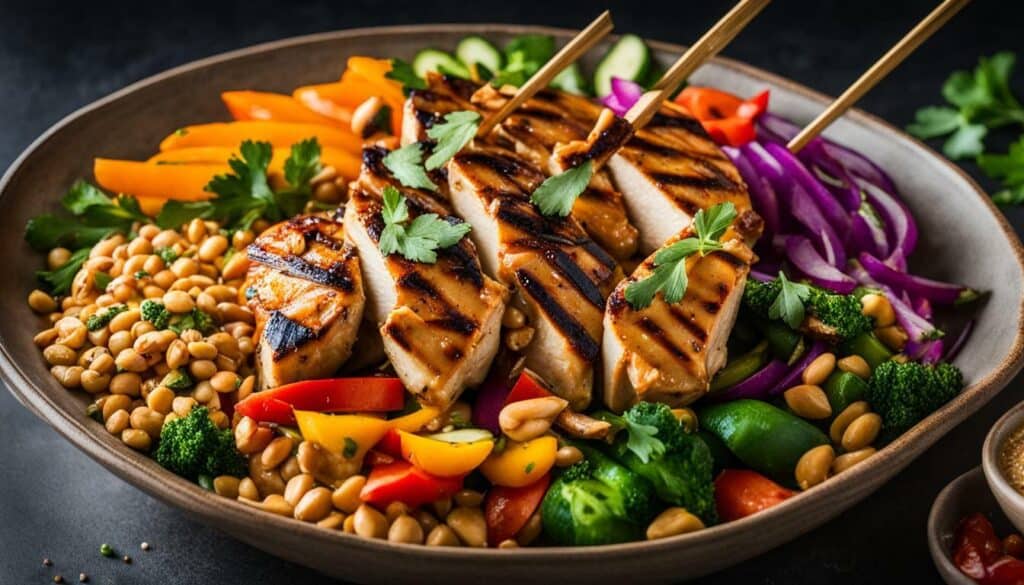
When selecting peanut butter for your homemade peanut sauce, it is crucial to consider a few important factors to ensure you make a nutritious choice. The quality of your peanut butter will directly impact the flavor and nutritional value of your sauce. Here are some key considerations to keep in mind:
- Peanut Sauce Ingredients: Take a close look at the ingredients list on the peanut butter jar. Ideally, you want a product that contains only peanuts and perhaps a small amount of salt. Avoid peanut butters that have added sugars, hydrogenated oils, or artificial additives.
- Peanut Sauce Nutrition Facts: Analyzing the nutrition facts label is essential when choosing peanut butter. Look for a product that is high in healthy fats, moderate in protein, and low in sugar and sodium. Opt for peanut butter that offers a good balance of macronutrients and essential vitamins and minerals.
- Texture and Consistency: Consider your personal preference for texture. Whether you prefer creamy or crunchy peanut butter, ensure it aligns with your desired peanut sauce texture. Keep in mind that crunchy peanut butter may add extra texture to your sauce, while creamy peanut butter will result in a smoother finish.
Remember, not all peanut butter products are created equal. Some brands may use lower-quality peanuts or additives that can affect the overall taste and nutritional value of your peanut sauce. To make an informed choice, take the time to read labels and choose peanut butter that aligns with your dietary preferences and health goals.
Choosing the Right Peanut Butter Image
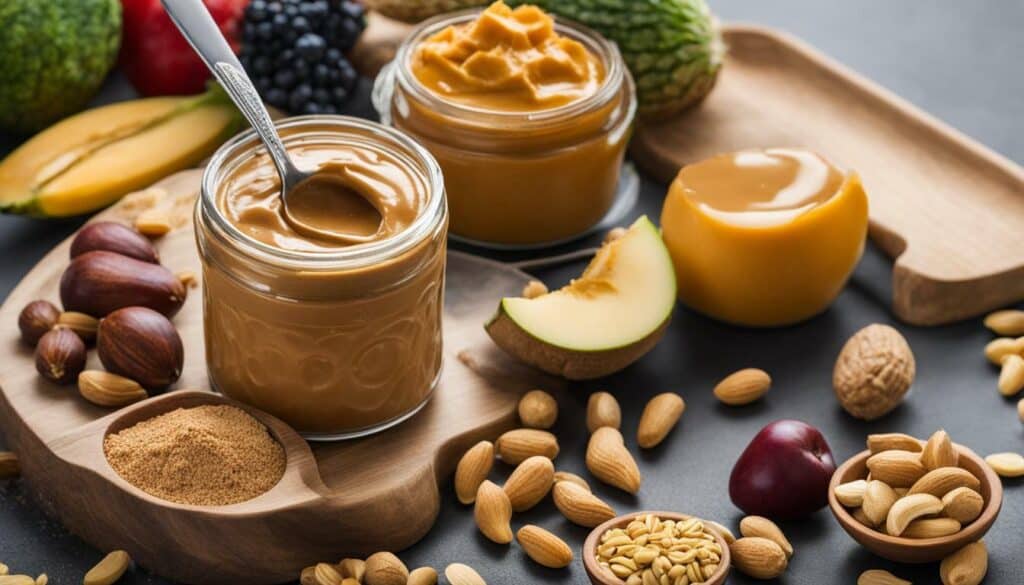
By making careful considerations when selecting peanut butter for your homemade peanut sauce, you can ensure that you create a delicious and nutritious dish. Don’t be afraid to experiment with different brands and types of peanut butter to find the perfect fit for your taste buds and dietary needs.
Conclusion
By exploring the calorie content and nutritional profile of peanut sauce, we have gained valuable insights into this popular condiment’s role in a healthy and balanced diet. In my research, I found that there are various types of peanut butter available, including crunchy and creamy options. Both types offer nutritional benefits, such as healthy fats, protein, fiber, and essential vitamins and minerals. While creamy peanut butter generally has slightly fewer calories than crunchy peanut butter, the choice between the two ultimately depends on personal preference and the culinary application.
Furthermore, I discovered a nutritious alternative to traditional peanut butter called PBfit. This popular peanut butter powder offers the flavor of peanut butter with fewer calories and less fat. With 87% less fat than regular peanut butter, PBfit is high in protein and fiber, making it a suitable choice for those seeking a balanced diet. Additionally, PBfit is lower in sodium, free from added sugar, and is non-GMO and gluten-free.
When incorporating PBfit into peanut sauce recipes, we can elevate the nutritional value of the sauce while enjoying its delicious taste. PBfit is a versatile ingredient that can be used in various culinary applications, offering a healthier alternative without compromising on flavor. It is widely available and affordable, making it accessible to everyone.
However, it is important to read nutrition labels and choose peanut butter products with minimal additives. Making informed choices and being mindful of the calorie content and nutritional profile of peanut sauce ingredients can help us maintain a balanced diet and enjoy this flavorful condiment guilt-free.
FAQ
Q: What are the different types of peanut butter available?
A: The two main types of peanut butter are crunchy and creamy. Crunchy peanut butter contains small pieces of roasted peanuts, while creamy peanut butter is smooth and silky.
Q: What are the nutritional benefits of peanut butter?
A: Both crunchy and creamy peanut butter provide healthy monounsaturated fats, protein, fiber, and essential vitamins and minerals. They are a nutritious addition to your diet.
Q: Is crunchy peanut butter higher in calories than creamy peanut butter?
A: Generally, creamy peanut butter has slightly lower calorie content than crunchy peanut butter.
Q: Does crunchy peanut butter have more sugar than creamy peanut butter?
A: Yes, crunchy peanut butter tends to have slightly higher sugar content due to added sugar particles for texture.
Q: What is PBfit and how does it compare to traditional peanut butter?
A: PBfit is a peanut butter powder that offers the flavor of peanut butter with fewer calories and less fat. It contains 87% less fat than traditional peanut butter and is high in protein and fiber.
Q: Is PBfit a healthy alternative to traditional peanut butter?
A: Yes, PBfit is a nutritious alternative to traditional peanut butter. It is lower in fat, higher in protein and fiber, and contains essential vitamins and minerals. It is also non-GMO, gluten-free, and does not have added sugar.
Q: How can PBfit be used in peanut sauce recipes?
A: PBfit can be incorporated into peanut sauce recipes as a healthier alternative to traditional peanut butter. It offers the flavor of peanut butter with fewer calories and less fat.
Q: What should I consider when choosing peanut butter products for peanut sauce?
A: When choosing peanut butter products for peanut sauce, it is important to read nutrition labels and choose products with minimal additives. Look for options that provide the desired flavor and nutritional benefits.
Q: What are the key findings about peanut sauce calories and its nutritional profile?
A: Peanut sauce made with either crunchy or creamy peanut butter can be a nutritious addition to your diet. The calorie content may vary slightly between the two types of peanut butter. PBfit offers a lower calorie and healthier alternative to traditional peanut butter.
Are Peanut Sauce Calories Similar to Caramel Corn Calories?
The caramel corn calorie breakdown differs from peanut sauce calories. While caramel corn is typically high in calories due to its sugar coating, peanut sauce calories tend to come from its nutty base. Comparing the two, it’s clear that caramel corn typically contains more calories per serving.

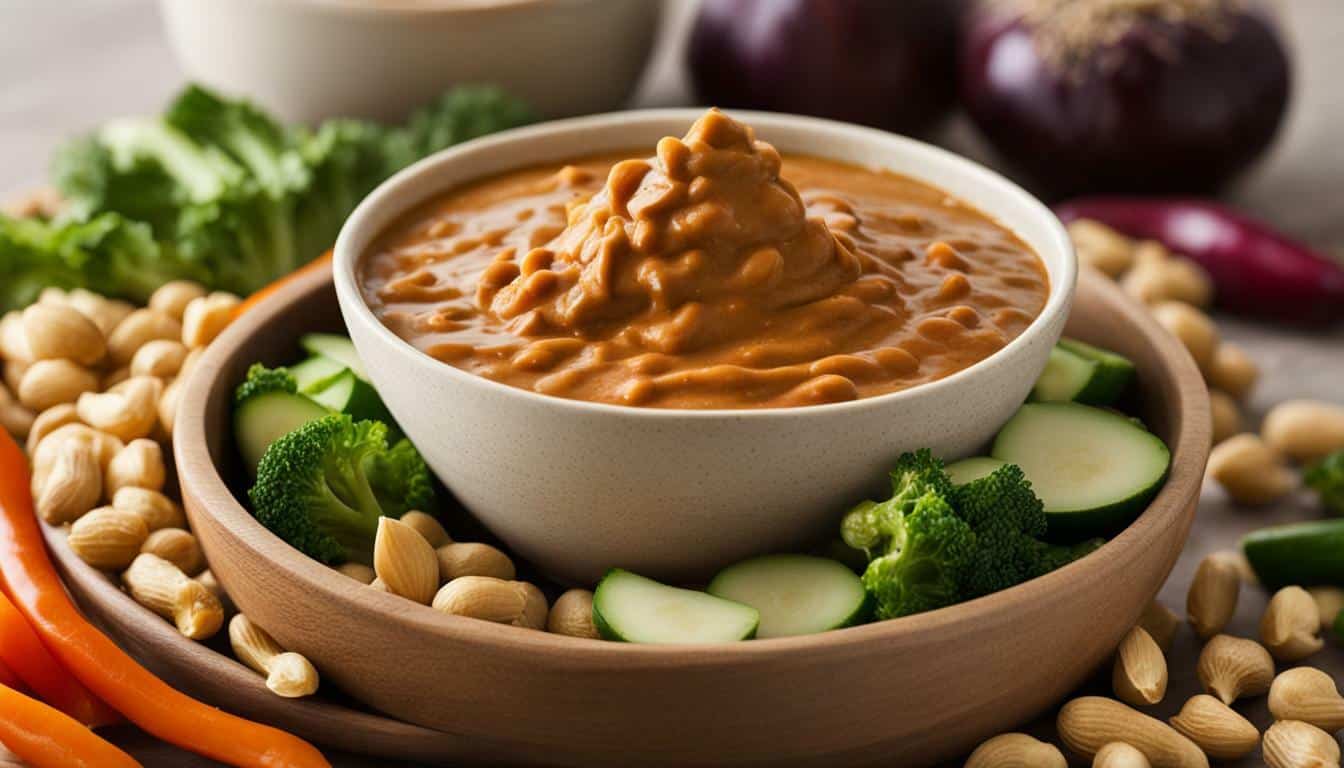



Leave a Reply